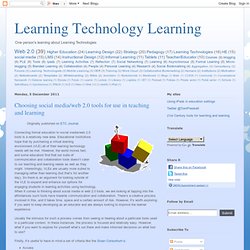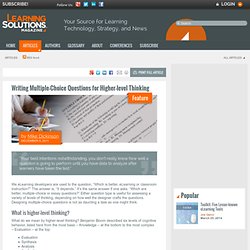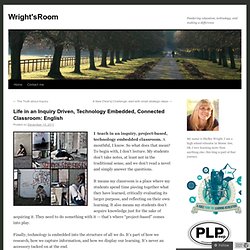

Essential Skills for 21st Century Survival: Part 6: Storytelling. This is part 6 in a 12 part series.

The first five skills were Pattern Recognition, Environmental Scanning, Network Weaving, Foresight, and Conscious Awareness. :: storytelling :: The following video by Jonah Sachs, creative director at Free Range Studios has prompted me to get back to completing the next installment in this Essential Skills series. He does a beautiful job revealing the secrets of effective and high-impact storytelling. Jonah Sachs at Compostmodern ’11 from AIGA San Francisco on Vimeo. One of the concepts Jonah presents is that of a “myth gap.” Like now. Another way of saying this is that the cultural narrative is broken. Most of us are acutely aware of this current state of affairs, especially in the broader context of systemic change. IfItWereMyHome.com. Choosing social media/web 2.0 tools for use in teaching and learning.
Connecting formal education to social media/web 2.0 tools is a relatively new area.

Educational institutions hope that by purchasing a virtual learning environment (VLE) all of their learning technology needs will be met. However, the world moves fast, and some educators find that our suite of communication and collaboration tools doesn’t cater to our teaching and learning needs as well as they might. Interestingly, VLEs are usually more suited to managing rather than learning (but that’s for another day). So there is an argument for looking outside of the VLE to expand and enhance our options for engaging students in learning activities using technology. When it comes to thinking about social media or web 2.0 tools, we are looking at tapping into the affordances such tools have towards communication and collaboration. Usually the stimulus for such a process comes from seeing or hearing about a particular tools used in a particular context. What type of tool? Scoping out tools? Machinarium. National Punctuation Day.
The Differentiator. Try Respondo!

→ ← Back to Byrdseed.com The Differentiator The Differentiator is based on Bloom's Taxonomy, Kaplan and Gould's Depth and Complexity, and David Chung's product menu. Try It In: French Dutch • Tweet It • Like Byrdseed • Pin It Students will judge the ethics of the [click to edit] using a textbook and create an essay in groups of three. Revised Bloom's Taxonomy adapted from "A Taxonomy for Learning,Teaching, and Assessing: A Revision of Bloom's Taxonomy of Educational Objectives" by Anderson and Krathwohl Depth and Complexity adapted from The Flip Book by Sandra N.
Depth Big Idea Unanswered Questions Ethics Patterns Rules Language of the Discipline Essential Details Trends Complexity Multiple Points Of View Change Over Time Across the Disciplines Imperatives Origin Convergence Parallels Paradox Contribution Key Words Consequences Motivations Implications Significance. Cybrary Man's - Assessments. Writing Multiple-Choice Questions for Higher-level Thinking by Mike Dickinson. “Your best intentions notwithstanding, you don’t really know how well a question is going to perform until you have data to analyze after learners have taken the test.”

We eLearning developers are used to the question, “Which is better, eLearning or classroom instruction?” The answer is, “It depends.” It’s the same answer if one asks, “Which are better, multiple-choice or essay questions?” Either question type is useful for assessing a variety of levels of thinking, depending on how well the designer crafts the questions. Designing multiple-choice questions is not as daunting a task as one might think. What is higher-level thinking?
What do we mean by higher-level thinking? 2 minute assessment grid. About Me « Surviving English. Historical Thursday: Agostino Ramelli’s Bookwheel. Life in an Inquiry Driven, Technology Embedded, Connected Classroom: English. I teach in an inquiry, project-based, technology embedded classroom.

A mouthful, I know. So what does that mean? To begin with, I don’t lecture. My students don’t take notes, at least not in the traditional sense, and we don’t read a novel and simply answer the questions. It means my classroom is a place where my students spend time piecing together what they have learned, critically evaluating its larger purpose, and reflecting on their own learning. Finally, technology is embedded into the structure of all we do. In my English classroom, this looks a lot different than in my biology & chemistry classrooms (which you can read about here). Meeting curriculum and teaching goals My curriculum states that I need to develop skills in 5 areas: reading, writing, viewing & representing, listening and speaking. Whenever we begin a new inquiry unit, research is always involved.
After researching, we come back together to discuss what needs to happen next. 10 Cool Uses Of Wolfram Alpha If You Read And Write In The English Language. It took me some time to wrap my head around Wolfram Alpha and the queries it uses to spout out those results.

A bit of time with it helped me look beyond what earlier seemed like computational mumbo-jumbo, and see the really practical ways I could use Wolfram Alpha. It was love at third sight probably which made me write 10 Search Terms To Put Wolfram Alpha To Good Use Everyday. The love has endured as I have continued to broaden my career as a blogger and a voracious consumer of the English language. So, if you read and write in English, come with me as we try to align a language and some computational logic to come up with data that could help us in our reading and writing. Word Definitions & The Story Behind It. What makes a good project. 40 Inspiring Quotes About Reading From Writers.